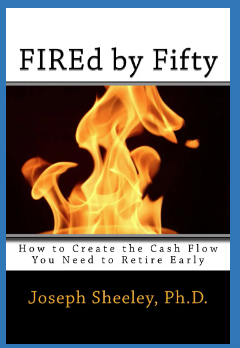
Before the 401k, there was the IRA. The simple investment account that anyone who had earned income could use to save for retirement. For many years contributions to IRAs were held at a paltry $2000, but about a decade ago they were raised to $5500 per year . Today they have been raised to $7000 per year. Put away $7000 for both yourself and your spouse into IRAs each year and you really start saving up a serious amount for retirement.
(Note, this site contains affiliate links. As an Amazon Associate I earn from qualifying purchases. When you click on an affiliate link and buy something, The Small Investor will get a small commission for the referral. You are charged nothing extra for the purchase. This helps keep The Small Investor going and free. I don’t recommend any products I do not fully support. If you would like to help but don’t see anything you need, feel free to visit Amazon through this link and buy whatever you wish. The Small Investor will get a small commission when you do, again at no cost to you.)
Before you can start investing, you need money to invest. Check out FIREd by Fifty: How to Create the Cash Flow You Need to Retire Early. You’ll learn how to control your cash flow so that you’ll have money to invest and grow wealth.

One good thing about IRAs is that they let you invest in virtually anything. One issue, however, is that they let you invest in virtually anything. For many people who really don’t understand investing this can be a serious issue. They just don’t know how to invest the money, so they do something foolish like:
1) Leave it in a money market fund so they lose money to inflation each year.
2) Invest in a set of high cost mutual funds recommended by their broker.
3) Put it all into a single stock, leaving open the chance that they can lose it all.
4) Trade in and out of different stocks, racking up a lot of commissions for their brokers but making little money themselves.
For those who don’t want to learn a lot about investing, but want to invest well, here is a really simple strategy for investing in your IRA:
- If you are younger than 50, put half of your money into a large cap index fund such as an S&P500 ETF and half of your money into a small cap index fund such as the Vanguard Small Cap ETF.
- When you are between 50 and 60, shift 30% of your money into a bond/income fund, the leave 40% of your money in the large cap fund and 30% in the small cap fund.
- When you are between 60 and 65, put 50% of your money in a bond/income fund and split the other 50% between a large cap and a small cap ETF, 30%/20%.
- Assuming you’re retiring at age 65, between age 63 and 65 start to sell off some of your assets to raise cash. Figure out how much cash you’ll need from your IRA each year in retirement and raise that much cash each year, placing it in a set of bank CDs set to mature just before you’ll need the money. If you’ll have another source of income and won’t need to tap into your IRA just yet, just stay fully invested in the half bond/half stock portfolio.
So there you have it – real simple but really effective. This strategy keeps your fees low, gives you plenty of diversification, has you take more risk when you’re young and can afford to wait for the market to recover, and starts to get more conservative when you start to near retirement. Is this the only strategy? No. But it is a good strategy and a fairly conservative one.
You can find other strategies for retirement investing and investing for all sorts of other purposes in Sample Mutual Fund Portfolios .

The only trick now is to stick to it and not let your emotions get the best of you. The worst thing you can do is let your emotions drive you into making a mistake. Keep investing no matter what the markets do. Stick to your allocations no matter what is happening. The biggest mistake people make that wrecks their retirement savings is to take money out early. The second worst is to shift money around in their retirement portfolio, trying to time the markets. Stay away from these mistakes and you’ll do just fine.
Want to learn the secrets to investing and really turbocharge your returns? Check out the second book in The Small Investor series, Investing to Win. This book presents 40 years of investing experience. Someone starting with zero knowledge of investing and the stock market could take this book and learn all that they needed to invest and do well. It would also be useful to someone who has invested and traded stocks for a while but who is really not getting the kind of returns desired.

Investing to Win
Your investing questions are wanted. Please leave them in a comment.
Follow on Twitter to get news about new articles. @SmalllIvy
Disclaimer: This blog is not meant to give financial planning or tax advice. It gives general information on investment strategy, picking stocks, and generally managing money to build wealth. It is not a solicitation to buy or sell stocks or any security. Financial planning advice should be sought from a certified financial planner, which the author is not. Tax advice should be sought from a CPA. All investments involve risk and the reader as urged to consider risks carefully and seek the advice of experts if needed before investing.
